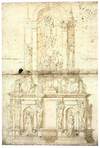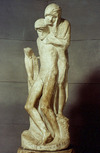Art History 2 Flashcards
(62 cards)

Portrait of Julius II, Raphael, 1512
finished months before his death
acorns on chair (family)
green walls-hope-> crossed keys in wallpaper
red robes- sacrificial color- charity- Mary
white- purity
beard- wouldn’t shave until French were defeated

Sistine Madonna, Raphael, 1513, Piacenza Convent
Madonnaand Child, Sixtus, St. Barbara
Sixtus looks like Julius II- beard, oak leaves of coat
Madonna floating, but coming towards us- great liason between earth and heaven, many emotions- fear, sorrow, resolution, focus, hope
baby- pose like Michelangelo Sistine fresco, grasping cloth like Pieta
angels based on real children
papel tiara at head of coffin/ledge-tradition after death

Donna Velata (Veiled Woman), Raphael, 1513
more mysterious, slightly turned from us, softer lines- Mona Lisa
no background
more ideal, dream-like
pearl in hair to show “value”

Baladassare Castiglione, Raphael, 1515
friend from Urbino, striking blue eyes, gentleman like, hat to cover baldness
riposo- inner calm, resting but not sleepy, grace
earthy colors VS Michelangelo’s acidy, bright color

Pope Leo X with Cardinals Giulio de’Medici and Luigi de’Rossi, Raphael, 1517
heavy winter clothing, collected objects in portrait, right hand side- first cousin future pope clement 7, behind- cardinal rossi- holds chair, protective, died 2 years after making cardinal
hands could be descendent of Mona Lisa

Galatea, Raphael, 1513, Villa Farnesina, Sala di Galatea, Rome, comissioned by Agostino Chigi (banker from Siena)
movement, spiral body, centrality

Transfiguration, Raphael, 1516-20, panel
last painting worked on before he died
first sign of Jesus’s divinity, apostles blinded by light
darker colors and shadows
healing of epilectic boy- chaos, source of salvation only through Christ
above Raphael’s tomb after he died

Sant’ Andrea, Leon Battista Alberti, designed 1470, Mantua
major precedent to Bramante
huge triumphant arches and other Roman elements

Inside Sant’ Andrea, Alberti, 1470, Mantua
piers separate chapels, no cloumns so you can see down the nave
dome and occulus, coffered barrel vault

Santa Maria presso San Satiro, Bramante, Milan, 1485
painted barrel vault, thinner piers, centrality in alter

Alter of Santa Maria presso San Satiro, Bromante, Milan
alter creates vanishing pt on tabernacle where host is kept
optical illusion- painted to look like apse
pendentives (triangular space to support dome) above

Renovated Santa Maria della Grazie, Bramante, begun 1492, Milan
brick, circle and rectangular shapes
renovations commissioned by Duke Sforza
Leonardo Last Supper fresco at same time

Santa Maria della Grazie, Bramante, 1492, Milan
rectangles and circles
carved out sections like vertical barrel vaults
no tiny aspes like Leonardo’s designs

Plan for Santa Maria della Grazie, Bramante, 1492, Milan
mosoleum replaces aspe and alter, chapel added on behind, centralized dome
nave gothic (not by Bramante)

Dome ceiling, Santa Maria della Grazie, Bramante, 1492, Milan
similar to Hagia Sofia-little windows and occulus

Tempietto, Bramante, 1511, Rome, commissioned by King Ferdinand and Queen Isabella of Spain
“believed” to be where Peter was martyred
originally wanted wide open space with columns around
centralized in space- first to have elevating elements
solid, stable rotunda- classical
doric columns (has base, plain column) and frieze- alternating designs-triglyph (3 columns) and metope (christian religious symbols-keys. chalices, etc.)
above- allternating scalloped and rectangular cut outs

Medal commemorating beginning of New St. Peter’s, bronze, 1506 design by Bramante
plan for new cathedral

Plan and axonometric reconstruction of New St. Peter’s design, Bramante’s design, 1506
alter in the middle right below center of dome- ultimate centrality
Greek cross- all legs the same size

section of dome for St. Peter’s as proposed by Bramante
1506
intended to be a perfect circle

Crossing of St. Peter’s as it was being built
tearing down Old St. Peter’s and building the new one at the same time

Plans for New St. Peter’s, Bramante and Raphael
Rahael was interested in Bramante’s design, but still wanted a nave for procession

Plans for St. Peter’s: Original, Bramante, Michelanglo, modern design

Cortile del Belvedere, Bramante, begun 1505
route from Papal Palace to Belvedere Palace
separating wall added later

Drawing of Cortile del Belvedere, Bramante, begun 1505, drawing from 1558-61
stairs up to Belvedere Palace
centrality to large gateways









































